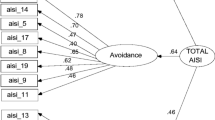Abstract
In this article, two investigations into the attachments of Dutch children to objects like cuddlies and blankets are reported upon. In the first study (n=140), the hypothesis of Spock that attachment to objects and thumbsucking are strongly related is tested. This hypothesis proved only partially to be correct. In the second study, (n=66) Ainsworth's hypothesis that attachment to objects is especially prevalent among securely attached children, is tested. The results of the Strange Situation point out that anxiously and securely attached children do not differ in their attachments to objects. Sex differences in this regard will also be discussed.
Similar content being viewed by others
References
Passmann RH, Halonen JS: A Developmental Survey of Young Children's Attachments to Inanimate Objects.J Genet Psychol 134:165–178, 1979.
Van derVeer R, Van IJzendoorn MH: Gehechtheid van jonge kinderen aan een object,Kind Adolescent 2:21–36, 1981.
Passman RH, Weisberg P: Mothers and blankets as agents for promoting play and exploration by young children in a novel environment: the effects of social and nonsocial attachment.Developmental Psychol 11:170–177, 1975.
Passman RH: Arounsal reducing proporties of attachment objects: Testing the functional limits of the security blanket relative to the mother.Developmental Psychol 12, 1976.
Busch F: Dimensions of the first transitional object.The Psychoanal Study Child 29:215–229, 1974.
Litt CJ: Children's attachment to transitional objects: a study of two pediatric populations.J Am Orthopsychiatry 1:51, 1981.
Gaddini R, Gaddini I: Transitional objects and the process of individuation: a study in three different social groups.J Am Acad Child Psychiatry 9:347–365, (1970).
Hong KM, Townes BD: Infants' Attachment to Inanimate Objects: A crosscultural study.J Am Acad Child Psychiatry 15:49061, 1976.
Winnicott DW: Transitional objects and transitional phenomena.Int J Psychoanal 34:85–97, 1953.
Greenacre P: The fetish and the transitional object.Psychoanal Study Child 24:144–164, 1969.
Bowlby, J.: Attachment and loss. Vol I: Attachment. Harmondsworth, Penguin, 1971.
Passman RH, Adams RE: Preferences for mothers and security blankets and their effectiveness as reinforcers for young children's behaviors.J Child Psychol Psychiatry 23:223–236, 1982.
Ainsworth MDS, Blehar MC, Waters E, Wall, S:Patterns of Attachment. A Psychological Study of the Strange Situation New Jersey: Lawrence Erlbaum Associates, 1978.
Rajecki DW, Lamb ME, Obmascher P: Toward a general theory of infantile attachment: a comparative review of aspects of the social bond.Behavioral Brain Sciences 1:417–464, 1978.
Spock B:Baby-en kinderverzorging. Amsterdam: B. Bakker, 1978.
Leach P:Baby en kind. Het volledige en praktische handboek voor de verzorging van kinderen. Amsterdam: Kosmos, 1979.
Furby L, Wilke M: Some Characteristics of infants' preferred toys.J Gen Psychol 140:207–219, 1982.
VanIJzendoorn MH, Tavecchio LWC, Goossens FA, Vergeer MM: How B is B4? Attachment and security of dutch children in Ainsworth's Strange Situation and at home.Psychol Reports, 52:683–691, 1983.
Goossens FA, Swaan J: De Stange Situation in Nederland: verslag van een vooronderzoek.Kind Adolescent 4:67–79, 1983.
Boniface D, Graham P: The three-year-old and his attachment to a special soft object.J Child Psychol Psychiat 20:217–224, 1979.
Garrison W, Earls F: Attachment to a special object at the age of three years: Behavior and Temperament characteristics.Child Psychiatr Human Development 12:131–141, 1982.
Author information
Authors and Affiliations
Additional information
Thanks to J. Swaan en G. van Donselaar for their research assistance.
Rights and permissions
About this article
Cite this article
Van IJzendoorn, M.H., Goossens, F.A., Tavecchio, L.W.C. et al. Attachment to soft objects: Its relationship with attachment to the mother and with thumbsucking. Child Psych Hum Dev 14, 97–105 (1983). https://doi.org/10.1007/BF00707674
Issue Date:
DOI: https://doi.org/10.1007/BF00707674




